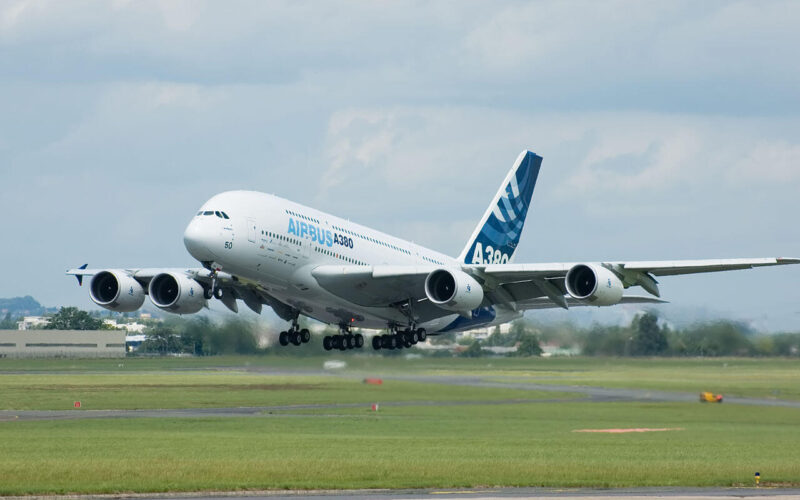Updated on 15/07/2019 at 11:35 am (UTC +2) with a comment from Emirates spokesperson.
The EASA (European Union Aviation Safety Agency) has ordered Airbus to inspect some of its older A380 superjumbos after cracks were detected on the wings of the airplanes. The list includes several of the world’s major airlines. EASA has called the issue a “potential unsafe condition”, meanwhile, Airbus assures that the safety of the world’s largest passenger jet has not been compromised.
The issue with A380 wing cracks
According to EASA’s Proposed Airworthiness Directive (PAD), issued on July 5, 2019, “Occurrences have been reported of finding cracks in the affected areas of the wing ORS [Outer Rear Spar] on in-service A380 aeroplanes. This condition, if not detected and corrected, could reduce the structural integrity of the wing,” the regulator stated. “To address this potential unsafe condition, Airbus plans to issue the SB [Service Bulletin] to provide inspection instructions,” the regulator informed.
The proposed directive, considered as “an interim action” while the agency drafts an airworthiness directive (AD), applies to 25 superjumbos currently in service around the world. The repairs need to be carried out within 15 years of the date the wing parts were manufactured. However, the regulator stated that further ADs for additional in-service A380s may follow based on the findings of the inspections.
In a statement, Airbus confirmed the issue has been detected. “We confirm that small cracks have been found on the outer rear wing spars of early production A380 aircraft. We have identified the issue and designed an inspection and repair scheme”. The European manufacturer said it supports EASA’s decision to issue the directive and that it is currently working with its customers.
So does that mean the affected double-deckers will be grounded? According to Airbus, the superjumbos in question can keep flying – inspections and repairs will be carried out during “scheduled heavy maintenance checks”. The plane maker also assures that the safety of the A380 fleet “is not affected”.
Response of affected airlines
Out of the global fleet of 25 affected aircraft, six airlines so far – Emirates, Qantas Airways, Singapore Airlines (SIA1) (SINGY) , Air France, Lufthansa (LHAB) (LHA) , and Hi Fly – have been listed in the first round of examinations.
Out of Qantas’ 12 A380 jets currently in-service, according to Airbus orders and deliveries book (end of June), six aircraft require inspection in the next few years. Confirming the information, a spokesperson for the airline told AeroTime the first inspection is not due until June 2020, with the last not due until May 2021. The airline said it has been working with Airbus on the issue “for some time”. Two inspections have already been completed, one in March and the other in July 2019, alongside scheduled maintenance.
In a statement, Qantas Head of Engineering, Chris Snook, said: “Inspections are not required on these aircraft for another year or two and are being done well in advance of the required timeframes. We have completed inspections on two aircraft and there were no concerns with the structural integrity of the wing”.
Singapore Airlines (SIA1) (SINGY) , which operates 19 A380s (as of June 2019), has four jets that need to be checked. “We are aware of the proposed Airworthiness Directive (AD) from EASA regarding the inspection of outer rear spars of the wings of some A380 aircraft. Four of our A380s will require inspections,” a spokesperson for the airline told AeroTime. “The safety of our customers and crew is of utmost priority, and we will ensure that we are in full compliance with the inspection requirements”.
Lufthansa (LHAB) (LHA) currently has 14 superjumbos in its mainline fleet, based in Frankfurt and Munich. Responding to AeroTime’s enquiry, a spokesperson for Lufthansa Group stated the safety of its passengers “is not affected” by the issue. “When the appropriate instruction is issued, Lufthansa (LHAB) (LHA) will implement it accordingly. A restriction of A380 flight operations is not to be expected (… one aircraft affected)”.
Emirates, which is the world’s largest A380 operator, with 111 superjumbos currently in-service with the airline, has begun inspections on nine aircraft. “Safety is always our top priority, and all our aircraft undergo regular and comprehensive checks,” a spokesperson for the Dubai-based airline said in a statement. ”We are aware of the proposed EASA directive, and have already scheduled and begun conducting the additional inspections on those aircraft identified. So far, there has been nothing untoward in the findings.”
It is not known how many of Air France’s 10 A380s currently in operation have been affected. Meanwhile, another European airline, Portuguese charter carrier Hi Fly, said it has been one of the first operators to have its A380 aircraft go through the inspection process. The airline told AeroTime its single A380 has already been checked “tip to tip”. The checks were performed last November by Airbus in Toulouse, France.
Hi Fly’s aircraft, which had been the only wet-lease superjumbo available in the world, has since left the carrier’s fleet and is currently being leased to Air Madagascar, Simple Flying reported earlier this month.
The inspections, as outlined in EASA’s directive, require phased-array ultrasonic testing methods for the external wing box and ultrasonic testing methods for the internal wing box. If damage is detected, airlines must alert Airbus for the repair instructions, before the next flight.

